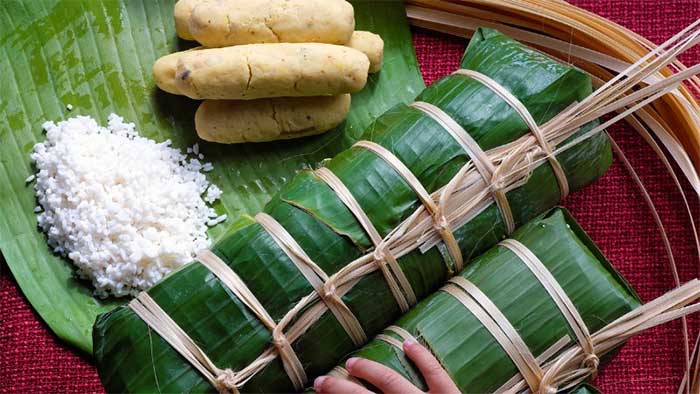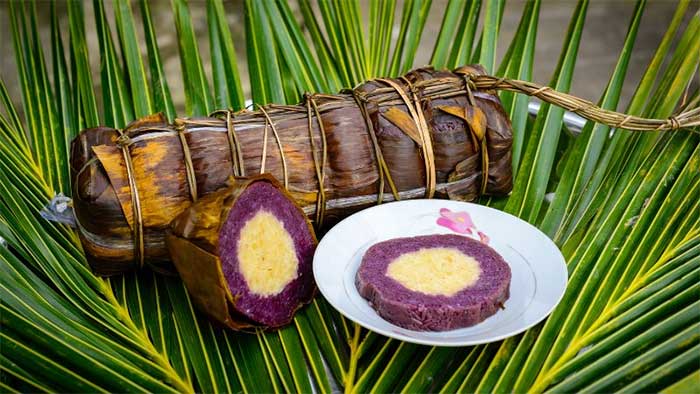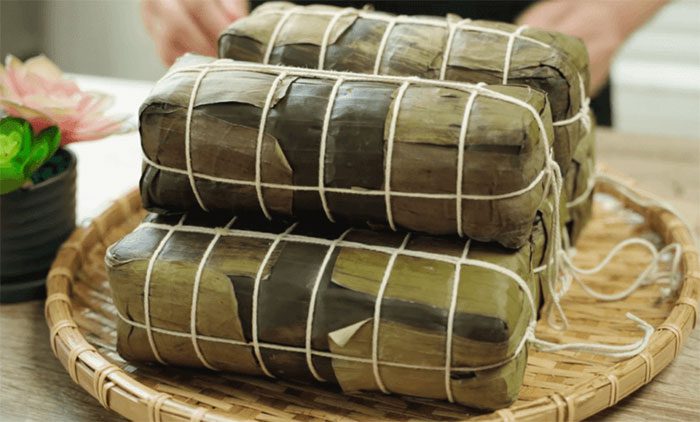It is unclear when the cylindrical sticky rice cake known as “bánh tét” became a staple in the traditional New Year feast of the Southern Vietnamese. In today’s article, we will explore the origins and significance of bánh tét!
While in the North, the New Year is celebrated with the square sticky rice cake called “bánh chưng,” which is tied to the legend of the “bánh chưng and bánh dày” by Prince Lang Liêu, the 18th son of King Hùng, symbolizing the round sky and square earth, bánh tét also has its own intriguing stories of origin and significance.
According to New Year customs, bánh tét is cooked on the night of the 30th of December, which is New Year’s Eve. The whole family gathers around the pot of bánh tét, creating a warm and prosperous atmosphere for family reunions during the holiday.
During Tết, the people of the South only prepare two types of bánh tét: vegetarian bánh tét and savory bánh tét. The vegetarian bánh tét is offered to ancestors and the heavens, while the savory version is served during meals, often accompanied by pickled vegetables, salted shallots, and braised pork.

Bánh tét is an essential dish in the Southern Tết feast.
The Origin of Bánh Tét
Some cultural experts explain that the cylindrical bánh tét enjoyed by Southerners during Tết today is likely a product of cultural exchange between the Vietnamese and the Cham people, or it may be a continuation of the traditions passed down from ancestors. When the Vietnamese began to clear and expand into the Southern lands, they absorbed elements of the Cham culture, including the worship of rice deities, leading to the creation of bánh tét as we know it today.
In addition to its cultural origins, there are also historical anecdotes explaining the formation of bánh tét. One such story recounts how King Quang Trung, during the Tết festival while fighting against the Qing army, allowed his soldiers to rest.
One soldier presented the king with a cylindrical cake wrapped in banana leaves, which the king found delicious and inquired about its name. The soldier replied that it was a cake his wife used to wrap for him to eat on the road, and each time he ate it, he remembered her and his homeland.

Bánh tét is also known as bánh Tết.
Upon hearing this, King Quang Trung was deeply moved and ordered everyone to prepare this cake for Tết, naming it bánh Tết. This is regarded as the origin of bánh Tết in the traditional Vietnamese New Year.
Why Is It Called Bánh Tét?
Just like its origins, the name bánh tét also has numerous stories explaining its designation. As previously mentioned, bánh tét is also referred to as bánh Tết, but over time, due to regional pronunciation, bánh Tết has been colloquially shortened to “bánh tét.”
There are also explanations suggesting that the term “tét” refers to the action of slicing the cake. When consuming this type of cake, users would unwrap it and “tét” or cut it into small rounds. Hence, locals refer to this cake as bánh tét, similar to the action of cutting the cake.
The Significance of Bánh Tét
According to the beliefs of our ancestors, all foods consumed during Tết carry meanings of remembrance for those who have passed, wishing for warmth and unity within families, and expressing gratitude to the heavens for a bountiful harvest, and bánh tét is no exception.
The traditional bánh tét, wrapped in multiple layers of leaves, symbolizes the mother protecting her child and reflects the Vietnamese desire for reunion during Tết. Additionally, the green bánh tét with yellow mung bean filling evokes the green of the countryside, inspiring the dream of a peaceful spring and a stable livelihood for every household.

Bánh tét embodies the Vietnamese wish for family reunion during Tết.
The bánh tét, or bánh Tết, may appear simple but is imbued with deep meanings, symbolizing the hope for family unity and prosperity. Thus, according to Tết customs, on the evening of the 29th and 30th of Tết, families stay up late around the pot of bánh, with children playing or helping grandparents prepare the fire, while adults compete to wrap the cakes, creating a warm and prosperous atmosphere for the holiday.





















































